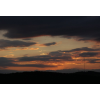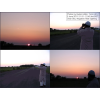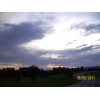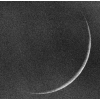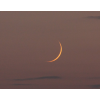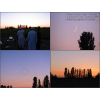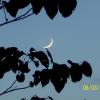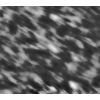Visibility of Rajab Crescent 1432 AH
- When to Observe Rajab Waxing (NEW) Crescent ?
- Rajab Waxing (NEW) Crescent Observation Results
- The OFFICIAL First Day in Different Countries
- When to Observe Jumadal Al-Aakherah Waning (OLD) Crescent ?
- Jumadal Al-Aakherah Waning (OLD) Crescent Observation Results
When to Observe Rajab Waxing (NEW) Crescent ?
The geocentric conjunction (Geocentric New Moon) will occur Inshalla on (Wednesday 01 June 2011) at 21:03 UT.
Sighting the new crescent on (Wednesday 01 June 2011) and (Thursday 02 June 2011) is shown in the below graphs using the program Accurate Times by Mohammad Odeh according to Odeh criterion. Where:-
- It is impossible to see the crescent from the areas located under the red color. Because either the Moon on this day sets before the Sunset and/or the topocentric conjunction occurs after the Sunset.
- The crescent is expected to be seen by optical aid only from the areas located under the blue color.
- The crescent is expected to be seen by optical aid from the areas located under the magenta color. In these areas the crescent could be seen by naked eye if the atmospheric conditions are superb and the observer is experienced.
- The crescent is expected to be easily visible by naked eye from the areas located under the green color.
- The crescent cannot be seen from uncolored areas, even though the Moon sets in these locations after the Sunset and the topocentric conjunction occurs before the Sunset, but the Moon is not sufficiently illuminated in order to be seen as crescent even by optical aid.
- Kindly notice that the below graph shows the possibility of seeing the crescent from areas between 60 degrees north of Equator down to 60 degrees south of Equator.
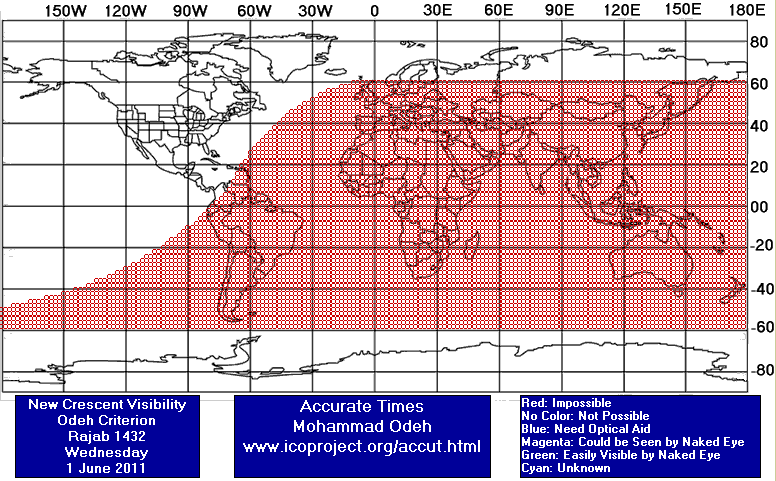
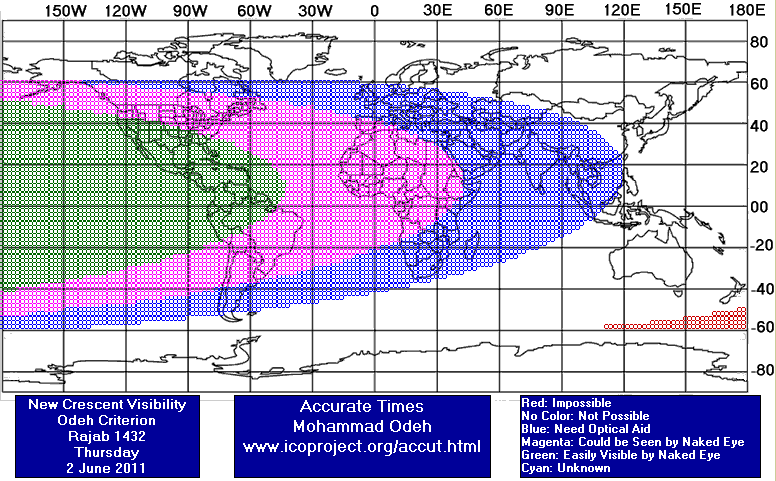
According to the Universal Hejric Calendar (UHC), which is based on the calculated crescent visibility, the start of this month in the Eastern Region will be on Friday 03 June 2011 and in the Western Region will be on Friday 03 June 2011. Kindly notice that the UHC is a pre-calculated calendar, which adopts a certain criterion to start the new Hejric month. Your country/organization might adopt different criterion to start the new Hejric month. So it is highly advised to read the UHC website before giving any judgment.
- Results of seeing the crescent, and the first day of the month in different countries will be added here Inshalla as we receive the reports from ICOP's members. If you wish to be a member in ICOP, or to know more about it, kindly click here.
Rajab Waxing (NEW) Crescent Observation Results
Thu 02 June 2011
Germany
Eng. Martin Elsaesser said: "We did a nice family trip in the evening to see the young crescent of 2. June, trying to get out from under a large and fast moving cloud front. After driving 140km, we found a gap in the clouds, where we could see the sun and enough sky above it. While trying to quickly setup the equipment we encountered some problems with the power supply. This took several minutes to resolve and when we finally got the first look at the correct position in the sky the rushing cloud front had approched again and just covered the spot. Having left the highway earlier, we had no chance of chasing that gap in the clouds further, so we had to accept defeat for this evening. Some food and drink and playing with the kids eased the disappointment and we even got home before midnight."
Eng. Gerhard Ahmad Kaufmann said: "Lying already a little outside the Yallop D area and with a sunset-moonset lag time of only 49 minutes, only absolutely perfect conditions would have offered a slight chance to observe the crescent. Although the atmosphere was very clear (30% rH, visibility range 70 km), the sky at the western horizon was pervaded with thin cloud layers up to an altitude of 8-10 degrees. This caused a very spectacular orange sunset, but of course completely destroyed any chance to observe the crescent. Nothing could be seen of it."
Norway
Mr. Milad Ali Ershaghi said: "On Thursday, June 2, 2011 I tried to look for the new moon of Rajab from Bergen, Norway between 11:30pm and 11:44pm - as sunset was at 10:50pm and moonset was at 11:44pm. The sky was completely overcast and I was unable to see the moon."
Saudi Arabia
Mr. Saleh Al-Saab said: "The altitude of the crescent was around (7) degrees at sunset in most of the kingdom but the weather generally was partly cloudy or dusty all over. It was not seen by any telescope . "
United Kingdom
Eng. Qamar Uddin said: "On Thursday 2 June 2011 (29 Jumada Al-Ukhra 1432 AH) many people from throughout UK have attempted to sight the crescent moon (Hilal) of Rajab after sunset. None of the groups were able to sight the Hilal, even though most places had absolutely superb clear sky conditions (see attached photos). SMS received from Morocco stated negative sighting. Therefore, the Ulama have decided that the month of Jumada Al-Ukhra 1432 AH will complete 30 days and the month of Rajab 1432 AH will start from Saturday 4 June 2011, Insha-Allah."
United States
Eng. Mohammad Rahman said: "We (5 persons) tried to see the moon but the crescent moon was not seen with bare eyes."
Dr. Javad Torabinejad said: "This evening (Thursday, June 02, 2011), because of a mostly cloudy western horizon in Blacksburg, VA, the crescent of the month of Rajab was not sighted. My son and I arrived at the sighting location at 8:18 pm (sunset: 8:36 pm EDT) and looked for the crescent in the clear patches in the west/northwest horizon; I was using a pair of binoculars (7x50). We left at 9:14 pm (moonset: 9:35 pm EDT). At 8:55 pm, the temperature, relative humidity, and pressure were 21 C, 56%, and 1023 mbar, respectively."
Dr. Hussain Dashti said: "Today, June 2nd 2011, I was able to sight the crescent from Gainesville, Florida. The sky was partially cloudy, thus, I was only able to see it with a 10X50 binocular before it disappeared behind the clouds. In addition, smoke filled the air, that might be due to farms burning in the area, which made sighting the crescent more difficult. "
Fri 03 June 2011
Australia
Mr. Afroz Ali said: "The crescent was sighted in numerous locations around Australia."
Bangladesh
Mr. ABM Ruhul Hassan said: "The crescent was seen just at sunset time. The sky was clear "
Germany
Eng. Martin Elsaesser said: "The crescent could easily be seen with naked eye after sunset. Also some hours earlier in daytime with a small telescope."
Ghana
Mr. Abdul-Aziz Anyang said: "Sorry for the late reporting. We had cloudy weather on Thursday June 2nd and Friday June 3rd. I had a late call (Saturday June 4th) from Mohammed in the Northern region of Ghana and he confirmed that he and some members in the community saw it for the first time on Friday June 3rd and as he speaks to me, it is clearly up in the sky (ie on the evening of Saturday June 4th). The greater Accra region due to very cloudy and rainy weather had not witness it since its appearance on the evening of Friday June 4th. "
South Africa
United Kingdom
Eng. Qamar Uddin said: "On Friday 3 June 2011 (30 Jumada Al-Ukhra 1432 AH) many people from throughout UK have been able to sight the crescent moon (Hilal) of Rajab after sunset. A large group of observers from York Astronomical Society Observatory were easily able to sight the Hilal by naked eye soon after sunset at 21:35 hrs BST (see attached photos). The above group comprised of Maulana Imran Lunat, Vashiullah Bodiyat, Abubakr Mulla and Yusuf Mulla, all from Batley. From York, Maulana Yusuf Mota, Qamar Uddin, Yusuf Foster and about 15 astronomers (following a fortnightly astronomy seminar). The UK Ulama (including Wifaq and Batley) have already decided yesterday to start the month of Rajab from Saturday 4 June 2011 by completing the month of Jumada Al-Ukhra 1432 AH as 30 days, Insha-Allah."
United States
Dr. Javad Torabinejad said: "The crescent was seen very easily."
The OFFICIAL First Day in Different Countries
Fri 03 June 2011
1 . Algeria
2 . Jordan
3 . Kuwait
4 . Oman
5 . Qatar
6 . Saudi Arabia
7 . Tunisia
8 . United Arab Emirates
9 . United States
Sat 04 June 2011
1 . Australia
2 . Bangladesh
3 . Germany
4 . Ghana
5 . Morocco
6 . South Africa
7 . United Kingdom
When to Observe Jumadal Al-Aakherah Waning (OLD) Crescent ?
The geocentric conjunction (Geocentric New Moon) will occur Inshalla on (Wednesday 01 June 2011) at 21:03 UT.
Sighting the OLD crescent on (Wednesday 01 June 2011) and on (Tuesday 31 May 2011) is shown in the below graphs using the program Accurate Times by Mohammad Odeh according to Odeh criterion. Where:-
- It is impossible to see the OLD crescent from the areas located under the red color. Because either the Moon on this day rises after the Sunrise and/or the topocentric conjunction occurs before the Sunrise.
- The crescent is expected to be seen by optical aid only from the areas located under the blue color.
- The crescent is expected to be seen by optical aid from the areas located under the magenta color.. In these areas the crescent could be seen by naked eye if the atmospheric conditions are superb and the observer is experienced.
- The crescent is expected to be easily visible by naked eye from the areas located under the green color.
- The crescent cannot be seen from uncolored areas, even though the Moon rises in these locations before the Sunrise and the topocentric conjunction occurs after the Sunrise, but the Moon is not sufficiently illuminated in order to be seen as crescent even by optical aid.
- Kindly notice that the below graph shows the possibility of seeing the crescent from areas between 60 degrees north of Equator down to 60 degrees south of Equator.
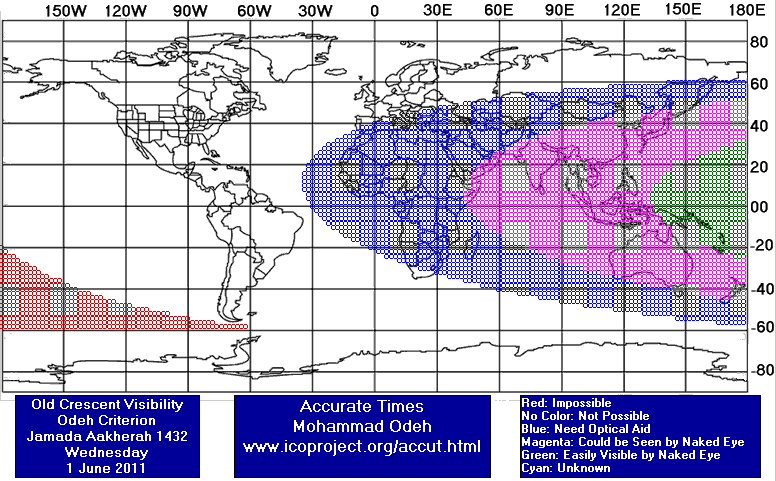
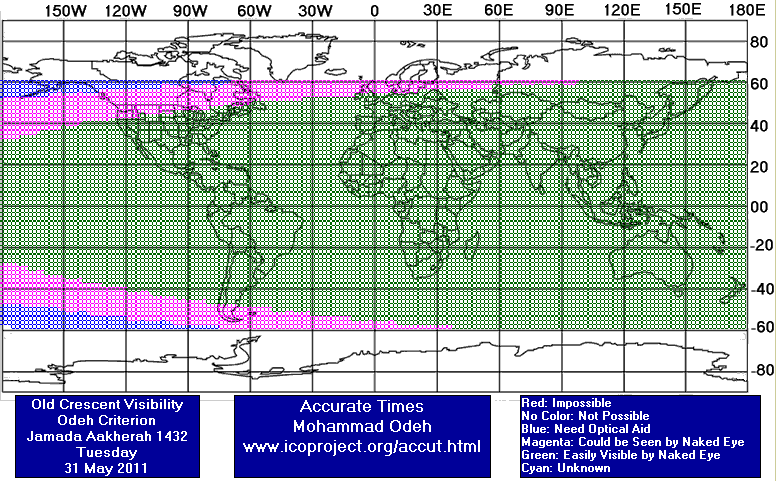
Jumadal Al-Aakherah Waning (OLD) Crescent Observation Results
Tue 31 May 2011
Germany
Eng. Martin Elsaesser said: "Weather conditions were very bad this morning, so the crescent could not be observed before sunrise. Some 4 hours later, we still had very much haze and cloud cover. It took almost 30 minutes to find a temporary gap in the clouds to see Venus. As i had no hope of seeing the crescent visually under these conditions, i used the imaging system to dig it out of the clouds. After some minutes of waiting, clouds and haze allowed the imaging system a short peek at the crescent, before more clouds covered it again. The resulting image is quite unsightly as a result of these conditions. "
United Kingdom
Eng. Qamar Uddin said: "The eastern horizon before sunrise was fairly clear with some patches of clouds, but the waning crescent was not seen from York."
